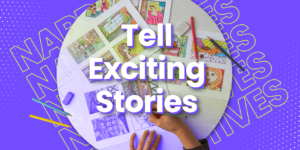You know there are a few key elements to any good story. And you’re probably already using many of them in your appeals and other communications. But you need to help your donors see the difference their support really makes by telling a donor-centric story.
So, how can you be more donor-centric in your year-end appeal? It’s time to find out!
What makes a donor-centric story?
Storytelling is the key to securing repeated gifts from long-term donors. And all stories should emphasize the donor’s role in making your mission a reality. Your donors must see themselves as an important part of your work.
There are two easy ways to develop a donor-centric story.
First, did the story in your appeal focus on your beneficiaries? If so, then show donors how they made this story happen by using phrases like “because of you…” and “with your help…” in your follow-up.
The second way is to appeal to a donor’s sense of self. This involves identifying a trait or value that drew a specific donor to your organization in the first place. You will then use this information to bring your donor closer to the story and your mission.
For example, an animal rescue can use different stories for dog owners and cat owners. As you know, many people see their pets as family members.
So, a story about how a helpless stray kitten was rescued will resonate more with cat owners. A story about an abused dog who found a loving home through rescue will appeal more to dog owners.
These approaches will help your supporters see themselves in the story and understand the impact of their donations.
LEARN MORE: There’s always a new story to tell.

Talk about a specific donor.
Another way to approach donor-centric storytelling is to focus on a specific donor who embodies your ideal donor profile. You can tell the story of what drew that individual to your organization and share what you’ve accomplished because of their generosity.
Then, make a connection to your recipient.
Use statements like, “Our work is possible because of donors like Ms. Smith and yourself,” or “You can make an impact, just like Ms. Smith.”
Ideally, donors should be able to see themselves in place of the subject of your donor-centric story. This is also a great way to show current and prospective donors how much you value the people who make your work possible!
LEARN MORE: Why do donors disconnect from your mission?

Think differently about your thank you’s.
Let’s face it. An email with “Thanks for the donation” as a subject line isn’t going to get people very excited. So, consider starting with something like “You Rock!” or “You made my day!” to shift the focus to the donor.
Your supporters will begin to wonder why their donation made you so excited instead of feeling like they are receiving the same boring message as everyone else. This language change will draw new donors to dig deeper into your organization and website to find out more.
Having someone else say thank you is another great way to be more donor-centric. Your supporters expect a thank you note from within your organization. But you can make a more personal connection by having a beneficiary, well-known major donor, or board member reach out as well.
It’s one thing when you talk about a donor’s role on the impact of your work.
But having this message come from someone who benefited directly is a more effective way to show the donor how they made a difference in a real person’s life.
And using well-known donors to reach out affirms others believe in the cause. They can use phrases like “I wanted to thank you for joining me…” or “I’m glad this is important to you too!”
LEARN MORE: The next step to thank and retain year-end donors.

Make donors feel valued.
Creating opportunities for further engagement can also help you be more donor-centric with your outreach. Invite donors who are already engaged to your next event. And keep them involved by letting them know about upcoming volunteer opportunities.
Allowing them to see how your organization operates behind the scenes gives the donor a special look into how you work towards your goal.
It’s not enough to tell a story in your appeals and other fundraising-related communications. And it’s not enough to send a simple thank you note after someone gives.
You need to build your outreach strategy with your audience in mind. And a donor-centric story is more likely to inspire someone to give than one that focuses on your organization.
While you may be tempted to go on and on about the great things you’ve accomplished, you need to remember that your supporters want to know how they are making a difference before they donate.
Want to look at your appeal draft with an amplifi development strategist? Click here!









